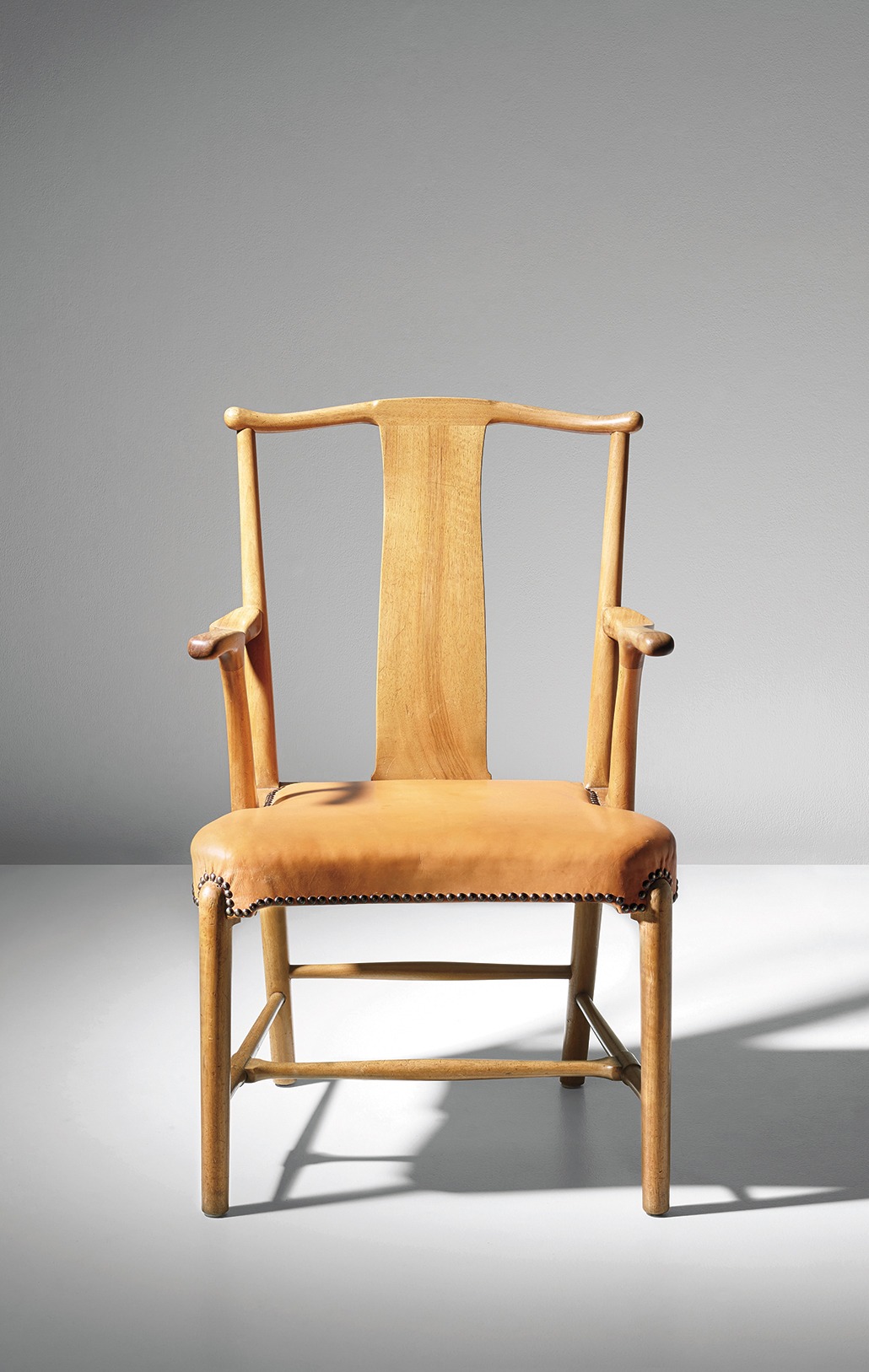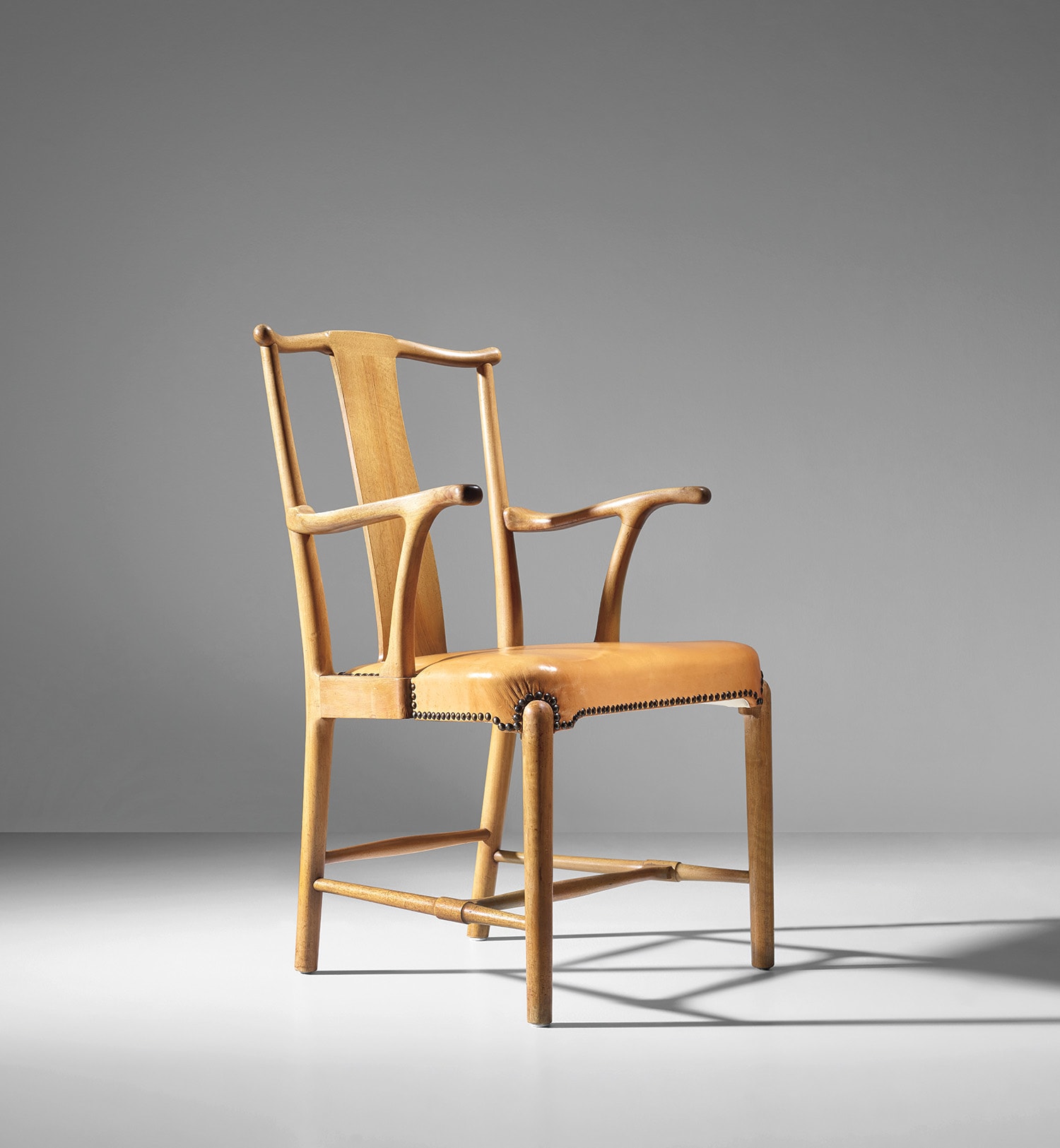





39
Hans J. Wegner
'Chinese' armchair
circa 1944
Walnut, leather, brass-plated steel nail heads.
92.4 x 58 x 55.5 cm (36 3/8 x 22 7/8 x 21 7/8 in.)
Executed by master cabinetmaker Johannes Hansen, Copenhagen, Denmark.
Full-Cataloguing
Phillips wishes to thank Marianne Wegner from the Hans J. Wegner Design Studio for her assistance cataloguing the present lot.
The present armchair designed by Hans J. Wegner in 1944 is a rare example from a series of chairs, reinterpreted from traditional Chinese models, reflecting twentieth-century Danish design theory and Wegner’s own highly prolific and inventive re-working of furniture, specifically chair, typologies. The high-back of the present design comprises a gently curved bent-wood back splat and organic, out-ward turning top rail, a shape also expressed through the chair’s sculptural armrests. These elements relate to characteristics of a Chinese chair dating from circa 1800 acquired by the Designmuseum Danmark in 1937 whilst Wegner was attending the Cabinetmaker Day School at the School of Arts and Crafts. Established in 1930, the Cabinetmaker Day School, located at the design museum, trained designers, foremen and cabinetmakers. The curriculum was largely informed by the ideas of the architect Kaare Klint, who founded and taught at the furniture school of the Royal Danish Academy of Fine Arts and who advocated for the study of historical furniture types as a model for functionalist design.
Assembled using interlocking mortise and tenon joints, the Chinese chair in the museum’s collection provided Wegner with an example of rational, integrated construction and a simplicity achieved through meticulous craftsmanship. Having trained in the cabinetmaking tradition, Wegner’s early designs already demonstrate an understanding of material and skilful use of joinery, which he applied to create sculptural forms in wood. In the present example, Wegner integrated the seat into the overall construction of the armchair giving the frame a greater lightness, whilst its curved, expressive shape responds to the human body. Transforming the restrained base of the Chinese model, in Wegner’s version, the vertical support of the armrests no longer extends straight through the front legs. However, he retains the original configuration of the back supports and legs by introducing a curved form that responds to the shape of the back splat. In addition to the armchair’s general construction, Dr. Craig Clunas discusses how Wegner preserved several classical details of Chinese carpentry, including the curve of the apron and its recessed panels, thus stressing the heritage of his designs (Craig Clunas, ‘The Chinese Chair and the Danish Designer’, The V&A Album 4, London, 1985, pp. 315, 317).
Wegner designed the present armchair, in addition to working on several variant models for Fritz Hansen, the year after he established his own studio. Preceding this, Wegner had worked in the architecture office of Arne Jacobsen and Erik Møller, who had won the commission to design the Aarhus City Hall, for which they entrusted Wegner to design the building’s furniture. During this time, Wegner spent his evenings working on his own projects and participating in competitions, which led to his partnership with master cabinetmaker Johannes Hansen in 1940, a distinguished and productive collaboration that would last half a century. Of great importance were Wegner’s furniture designs for Johannes Hansen’s stands at the Copenhagen Cabinetmaker’s Guild’s annual exhibitions, which he contributed to from 1941 until 1966. At the 1944 exhibition, Wegner presented a 1:5 scale model of an armchair, whose design closely relates to the present armchair, as well as to a drawing dating from the same year Wegner had submitted to the forerunner exhibition competition. Wegner may have made the scale model to help convey the design to the merchant E. Knuth Nielsen, who commissioned a set of four armchairs of the present design and four side chairs for his home in Aarhus, where Wegner also lived during this time. A period image of Mr. Nielsen’s dining room exists, and it is probable that the present armchair originates from this commission. Another known example of the armchair model was included in the 1965 exhibition at Johannes Hansen, celebrating the 50th year of the workshop and the 25th year of collaboration with Wegner.
The present armchair designed by Hans J. Wegner in 1944 is a rare example from a series of chairs, reinterpreted from traditional Chinese models, reflecting twentieth-century Danish design theory and Wegner’s own highly prolific and inventive re-working of furniture, specifically chair, typologies. The high-back of the present design comprises a gently curved bent-wood back splat and organic, out-ward turning top rail, a shape also expressed through the chair’s sculptural armrests. These elements relate to characteristics of a Chinese chair dating from circa 1800 acquired by the Designmuseum Danmark in 1937 whilst Wegner was attending the Cabinetmaker Day School at the School of Arts and Crafts. Established in 1930, the Cabinetmaker Day School, located at the design museum, trained designers, foremen and cabinetmakers. The curriculum was largely informed by the ideas of the architect Kaare Klint, who founded and taught at the furniture school of the Royal Danish Academy of Fine Arts and who advocated for the study of historical furniture types as a model for functionalist design.
Assembled using interlocking mortise and tenon joints, the Chinese chair in the museum’s collection provided Wegner with an example of rational, integrated construction and a simplicity achieved through meticulous craftsmanship. Having trained in the cabinetmaking tradition, Wegner’s early designs already demonstrate an understanding of material and skilful use of joinery, which he applied to create sculptural forms in wood. In the present example, Wegner integrated the seat into the overall construction of the armchair giving the frame a greater lightness, whilst its curved, expressive shape responds to the human body. Transforming the restrained base of the Chinese model, in Wegner’s version, the vertical support of the armrests no longer extends straight through the front legs. However, he retains the original configuration of the back supports and legs by introducing a curved form that responds to the shape of the back splat. In addition to the armchair’s general construction, Dr. Craig Clunas discusses how Wegner preserved several classical details of Chinese carpentry, including the curve of the apron and its recessed panels, thus stressing the heritage of his designs (Craig Clunas, ‘The Chinese Chair and the Danish Designer’, The V&A Album 4, London, 1985, pp. 315, 317).
Wegner designed the present armchair, in addition to working on several variant models for Fritz Hansen, the year after he established his own studio. Preceding this, Wegner had worked in the architecture office of Arne Jacobsen and Erik Møller, who had won the commission to design the Aarhus City Hall, for which they entrusted Wegner to design the building’s furniture. During this time, Wegner spent his evenings working on his own projects and participating in competitions, which led to his partnership with master cabinetmaker Johannes Hansen in 1940, a distinguished and productive collaboration that would last half a century. Of great importance were Wegner’s furniture designs for Johannes Hansen’s stands at the Copenhagen Cabinetmaker’s Guild’s annual exhibitions, which he contributed to from 1941 until 1966. At the 1944 exhibition, Wegner presented a 1:5 scale model of an armchair, whose design closely relates to the present armchair, as well as to a drawing dating from the same year Wegner had submitted to the forerunner exhibition competition. Wegner may have made the scale model to help convey the design to the merchant E. Knuth Nielsen, who commissioned a set of four armchairs of the present design and four side chairs for his home in Aarhus, where Wegner also lived during this time. A period image of Mr. Nielsen’s dining room exists, and it is probable that the present armchair originates from this commission. Another known example of the armchair model was included in the 1965 exhibition at Johannes Hansen, celebrating the 50th year of the workshop and the 25th year of collaboration with Wegner.